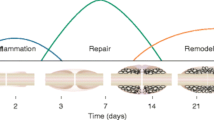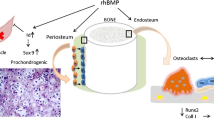Abstract
Many orthobiologic adjuvants are available and widely utilized for general skeletal restoration. Their use for the specific task of osteoporotic fracture augmentation is less well recognized. Common conductive materials are reviewed for their value in this patient population including the large group of allograft adjuvants categorically known as the demineralized bone matrices (DBMs). Another large group of alloplastic materials is also examined—the calcium phosphate and sulfate ceramics. Both of these materials, when used for the proper indications, demonstrate efficacy for these patients. The inductive properties of bone morphogenic proteins (BMPs) and platelet concentrates show no clear advantages for this group of patients. Systemic agents including bisphosphonates, receptor activator of nuclear factor κβ ligand (RANKL) inhibitors, and parathyroid hormone augmentation all demonstrate positive effects with this fracture cohort. Newer modalities, such as trace ion bioceramic augmentation, are also reviewed for their positive effects on osteoporotic fracture healing.
Similar content being viewed by others
References
Papers of particular interest, published recently, have been highlighted as: • Of importance •• Of major importance
Giannoudis P et al. Fracture healing in osteoporotic fractures: is it really different? A basic science perspective. Injury. 2007;38 Suppl 1:S90–9.
Friedlaender GE. Immune responses to osteochondral allografts. Current knowledge and future directions. Clin Orthop Relat Res. 1983;174:58–68.
Ramoshebi LN et al. Tissue engineering: TGF-beta superfamily members and delivery systems in bone regeneration. Expert Rev Mol Med. 2002;4(20):1–11.
Kirk JF et al. Osteoconductivity and osteoinductivity of NanoFUSE((R)) DBM. Cell Tissue Bank. 2013;14(1):33–44.
Moore ST et al. Osteoconductivity and osteoinductivity of Puros(R) DBM putty. J Biomater Appl. 2011;26(2):151–71.
Han B, Yang Z, Nimni M. Effects of moisture and temperature on the osteoinductivity of demineralized bone matrix. J Orthop Res. 2005;23(4):855–61.
Hierholzer C et al. Plate fixation of ununited humeral shaft fractures: effect of type of bone graft on healing. J Bone Joint Surg Am. 2006;88(7):1442–7.
Wilkins RM, Chimenti BT, Rifkin RM. Percutaneous treatment of long bone nonunions: the use of autologous bone marrow and allograft bone matrix. Orthopedics. 2003;26(5 Suppl):s549–54.
Peters CL et al. Biological effects of calcium sulfate as a bone graft substitute in ovine metaphyseal defects. J Biomed Mater Res A. 2006;76(3):456–62.
Yu B et al. Treatment of tibial plateau fractures with high strength injectable calcium sulphate. Int Orthop. 2009;33(4):1127–33.
Beuerlein MJ, McKee MD. Calcium sulfates: what is the evidence? J Orthop Trauma. 2010;24 Suppl 1:S46–51.
Kuhne JH et al. Bone formation in coralline hydroxyapatite. Effects of pore size studied in rabbits. Acta Orthop Scand. 1994;65(3):246–52.
De Long Jr WG et al. Bone grafts and bone graft substitutes in orthopaedic trauma surgery. A critical analysis. J Bone Joint Surg Am. 2007;89(3):649–58.
Nakahara H, Goldberg VM, Caplan AI. Culture-expanded periosteal-derived cells exhibit osteochondrogenic potential in porous calcium phosphate ceramics in vivo. Clin Orthop Relat Res. 1992;276:291–8.
Watson JT. Overview of biologics. J Orthop Trauma. 2005;19(10 Suppl):S14–6.
Watson JT. The use of an injectable bone graft substitute in tibial metaphyseal fractures. Orthopedics. 2004;27(1 Suppl):s103–7.
Mauffrey C et al. Incidence and pattern of technical complications in balloon-guided osteoplasty for depressed tibial plateau fractures: a pilot study in 20 consecutive patients. Patient Saf Surg. 2013;7(1):8. This study looked at the complications and steep learning curved involved with the use of inflation bone tamps to reduce depressed tibial plateau fractures.
Szpalski M, Gunzburg R. Applications of calcium phosphate-based cancellous bone void fillers in trauma surgery. Orthopedics. 2002;25(5 Suppl):s601–9.
Goff T, Kanakaris NK, Giannoudis PV. Use of bone graft substitutes in the management of tibial plateau fractures. Injury. 2013;44 Suppl 1:S86–94. Review of 19 studies comparing various bone graft substitutes which showed greater tolerance of early weight bearing and improved early functional outcomes with injectable calcium phosphate.
Bajammal SS et al. The use of calcium phosphate bone cement in fracture treatment. A meta-analysis of randomized trials. J Bone Joint Surg Am. 2008;90(6):1186–96.
Kim JK, Koh YD, Kook SH. Effect of calcium phosphate bone cement augmentation on volar plate fixation of unstable distal radial fractures in the elderly. J Bone Joint Surg Am. 2011;93(7):609–14. Augmentation of metaphyseal defects with calcium phosphate bone cement after volar locking plate fixation offered no benefit over volar locking plate fixation alone in elderly patients with an unstable distal radial fracture.
Suhm N, Gisep A. Injectable bone cement augmentation for the treatment of distal radius fractures: a review. J Orthop Trauma. 2008;22(8 Suppl):S121–5.
Lindner T et al. Fractures of the hip and osteoporosis: the role of bone substitutes. J Bone Joint Surg (Br). 2009;91(3):294–303.
Sanchez AR, Sheridan PJ, Kupp LI. Is platelet-rich plasma the perfect enhancement factor? A current review. Int J Oral Maxillofac Implants. 2003;18(1):93–103.
Friedlaender GE et al. Osteogenic protein-1 (bone morphogenetic protein-7) in the treatment of tibial nonunions. J Bone Joint Surg AmSuppl. 2001;83(A Suppl 1(Pt 2)):S151–8.
Blokhuis TJ, Calori GM, Schmidmaier G. Autograft versus BMPs for the treatment of non-unions: what is the evidence? Injury. 2013;44 Suppl 1:S40–2.
Lad SP et al. Cancer after spinal fusion: the role of bone morphogenetic protein. Neurosurgery. 2013;73(3):440–9. This study showed increased incidence of benign tumors especially of the nervous system in lumbar fusion patients exposed to BMP.
Morris CD, Einhorn TA. Bisphosphonates in orthopaedic surgery. J Bone Joint Surg Am. 2005;87(7):1609–18.
Amanat N et al. Optimal timing of a single dose of zoledronic acid to increase strength in rat fracture repair. J Bone Miner Res. 2007;22(6):867–76.
Lyles KW et al. Zoledronic acid and clinical fractures and mortality after hip fracture. N Engl J Med. 2007;357(18):1799–809.
Li J et al. Concentration of bisphosphonate (incadronate) in callus area and its effects on fracture healing in rats. J Bone Miner Res. 2000;15(10):2042–51.
Amanat N et al. A single systemic dose of pamidronate improves bone mineral content and accelerates restoration of strength in a rat model of fracture repair. J Orthop Res. 2005;23(5):1029–34.
Adolphson P et al. Clodronate increases mineralization of callus after Colles’ fracture: a randomized, double-blind, placebo-controlled, prospective trial in 32 patients. Acta Orthop Scand. 2000;71(2):195–200.
Schmidt GA et al. Risks and benefits of long-term bisphosphonate therapy. Am J Health Syst Pharm. 2010;67(12):994–1001.
Watts NB. Long-term risks of bisphosphonate therapy. Arq Bras Endocrinol Metabol. 2014;58(5):523–9.
Beninati F, Pruneti R, Ficarra G. Bisphosphonate-related osteonecrosis of the jaws (Bronj). Med Oral Patol Oral Cir Bucal. 2013;18(5):e752–8.
Janovska Z. Bisphosphonate-related osteonecrosis of the jaws. A severe side effect of bisphosphonate therapy. Acta Med (Hradec Kralove). 2012;55(3):111–5.
Egol KA et al. Healing delayed but generally reliable after bisphosphonate-associated complete femur fractures treated with IM nails. Clin Orthop Relat Res. 2014;472(9):2728–34.
Xue D et al. Do bisphosphonates affect bone healing? A meta-analysis of randomized controlled trials. J Orthop Surg Res. 2014;9:45. This recent meta-analysis looked at eight RCTs and found no delay in fracture healing with bisphosphonate therapy and recommended infusion after fracture fixation and lumbar fusion.
Moroni A et al. Alendronate improves screw fixation in osteoporotic bone. J Bone Joint Surg Am. 2007;89(1):96–101.
Moen MD, Keam SJ. Denosumab: a review of its use in the treatment of postmenopausal osteoporosis. Drugs Aging. 2011;28(1):63–82.
Cummings SR et al. Denosumab for prevention of fractures in postmenopausal women with osteoporosis. N Engl J Med. 2009;361(8):756–65.
Adami S et al. Denosumab treatment in postmenopausal women with osteoporosis does not interfere with fracture-healing: results from the FREEDOM trial. J Bone Joint Surg Am. 2012;94(23):2113–9. The three year results of this placebo-controlled trial showed no evidence of impaired healing in 303 patients treated with 60mg Denosumab showed no delay in fracture healing or increased complications even when administered immediately after surgery.
Flick LM et al. Effects of receptor activator of NFkappaB (RANK) signaling blockade on fracture healing. J Orthop Res. 2003;21(4):676–84.
Ulrich-Vinther M, Andreassen TT. Osteoprotegerin treatment impairs remodeling and apparent material properties of callus tissue without influencing structural fracture strength. Calcif Tissue Int. 2005;76(4):280–6.
Wu CC et al. Enhanced healing of sacral and pubic insufficiency fractures by teriparatide. J Rheumatol. 2012;39(6):1306–7.
Alkhiary YM et al. Enhancement of experimental fracture-healing by systemic administration of recombinant human parathyroid hormone (PTH 1-34). J Bone Joint Surg Am. 2005;87(4):731–41.
Nozaka K et al. Intermittent administration of human parathyroid hormone enhances bone formation and union at the site of cancellous bone osteotomy in normal and ovariectomized rats. Bone. 2008;42(1):90–7.
Rowshan HH et al. Effect of intermittent systemic administration of recombinant parathyroid hormone (1-34) on mandibular fracture healing in rats. J Oral Maxillofac Surg. 2010;68(2):260–7.
Aspenberg P et al. Teriparatide for acceleration of fracture repair in humans: a prospective, randomized, double-blind study of 102 postmenopausal women with distal radial fractures. J Bone Miner Res. 2010;25(2):404–14.
Peichl P et al. Parathyroid hormone 1-84 accelerates fracture-healing in pubic bones of elderly osteoporotic women. J Bone Joint Surg Am. 2011;93(17):1583–7.
Zhang D et al. The role of recombinant PTH in human fracture healing: a systematic review. J Orthop Trauma. 2014;28(1):57–62. Literature review of 16 publications, the majority of which are case reports, which found no evidence of impaired fracture healing in the setting of denosumab treatment and even anecdotal evidence of enhanced fracture healing.
Jolette J et al. Defining a noncarcinogenic dose of recombinant human parathyroid hormone 1-84 in a 2-year study in Fischer 344 rats. Toxicol Pathol. 2006;34(7):929–40.
Vahle JL et al. Skeletal changes in rats given daily subcutaneous injections of recombinant human parathyroid hormone (1-34) for 2 years and relevance to human safety. Toxicol Pathol. 2002;30(3):312–21.
Andrews EB et al. The US postmarketing surveillance study of adult osteosarcoma and teriparatide: study design and findings from the first 7 years. J Bone Miner Res. 2012;27(12):2429–37.
Bang UC, Hyldstrup L, Jensen JE. The impact of recombinant parathyroid hormone on malignancies and mortality: 7 years of experience based on nationwide Danish registers. Osteoporos Int. 2014;25(2):639–44.
Arcos D, Izquierdo-Barba I, Vallet-Regi M. Promising trends of bioceramics in the biomaterials field. J Mater Sci Mater Med. 2009;20(2):447–55.
Saidak Z et al. Strontium ranelate rebalances bone marrow adipogenesis and osteoblastogenesis in senescent osteopenic mice through NFATc/Maf and Wnt signaling. Aging Cell. 2012;11(3):467–74.
Peng S et al. The cross-talk between osteoclasts and osteoblasts in response to strontium treatment: involvement of osteoprotegerin. Bone. 2011;49(6):1290–8.
Yang F et al. Strontium enhances osteogenic differentiation of mesenchymal stem cells and in vivo bone formation by activating Wnt/catenin signaling. Stem Cells. 2011;29(6):981–91.
Peng S et al. Strontium promotes osteogenic differentiation of mesenchymal stem cells through the Ras/MAPK signaling pathway. Cell Phys Biochem. 2009;23:165–74.
Marie PJ, Felsenberg D, Brandi ML. How strontium ranelate, via opposite effects on bone resorption and formation, prevents osteoporosis. Osteoporos Int. 2011;22(6):1659–67.
Saidak Z, Marie PJ. Strontium signaling: molecular mechanisms and therapeutic implications in osteoporosis. Pharmacol Ther. 2012;136(2):216–26.
Wang C et al. Osteogenesis and angiogenesis induced by porous beta-CaSiO(3)/PDLGA composite scaffold via activation of AMPK/ERK1/2 and PI3K/Akt pathways. Biomaterials. 2013;34(1):64–77.
Xu S et al. Reconstruction of calvarial defect of rabbits using porous calcium silicate bioactive ceramics. Biomaterials. 2008;29(17):2588–96.
Lin K et al. Enhanced osteoporotic bone regeneration by strontium-substituted calcium silicate bioactive ceramics. Biomaterials. 2013;34:10028–42. These experiments demonstrated that strontium substituted calcium silicate ceramic scaffolds dramatically enhanced bone regeneration and angiogenesis in critical sized bone defects in ovarectomized mice. This paper also gave good background information on the function of strontium and silicate ions on bone metabolism and angiogenesis, respectively.
Food and Drug Administration, in Guidelines for preclinical and clinical evaluation of agents used in the prevention or treatment of postmenopausal osteoporosis. 1994: Rockville, USA: FDA.
Compliance with Ethics Guidelines
Conflict of Interest
JT Watson has received a speaker honorarium from Medtronic and served on an advisory panel for Bioventus.
DA Nicolaou declares no conflicts of interest.
Human and Animal Rights and Informed Consent
All studies by JT Watson involving animal and/or human subjects were performed after approval by the appropriate institutional review boards. When required, written informed consent was obtained from all participants.
Author information
Authors and Affiliations
Corresponding author
Additional information
This article is part of the Topical Collection on Orthopedic Management of Fractures
Rights and permissions
About this article
Cite this article
Watson, J.T., Nicolaou, D.A. Orthobiologics in the Augmentation of Osteoporotic Fractures. Curr Osteoporos Rep 13, 22–29 (2015). https://doi.org/10.1007/s11914-014-0249-5
Published:
Issue Date:
DOI: https://doi.org/10.1007/s11914-014-0249-5




